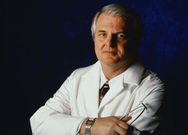 By Dennis Thompson
By Dennis Thompson
HealthDay Reporter
TUESDAY, Jan. 19, 2016 (HealthDay News) — Doctors facing death are less likely to demand aggressive care that might squeeze out a bit more extra time of life, two new studies show.
One study found that doctors facing the end of their lives are less likely than the general public to undergo surgery, be treated in an intensive care unit or die in a hospital.
“It seems to confirm the idea that physicians understand the limits of modern medicine at the end of life,” said lead author Joel Weissman. He is deputy director and chief scientific officer of the Center for Surgery and Public Health at Brigham and Women’s Hospital in Boston.
“When faced with that kind of decision, they choose to have more peaceful and less aggressive care at end of life,” Weissman added.
Those findings were backed up by the second study, which found that physicians and people with higher education are less likely to die in a hospital than people in the general population.
“This suggests that being well-educated has an influence on how we experience death,” said study author Dr. Saul Blecker, an assistant professor of population health at New York University School of Medicine.
However, Dr. Joseph Rotella, chief medical officer for the American Academy of Hospice and Palliative Medicine, said neither study showed extremely large differences between doctors and other people when it comes to dying.
“Although there were differences that were statistically significant, they were pretty small differences. I want to guard against over-interpreting what was actually seen in this study,” Rotella said.
Most people would like to die at home rather than in a hospital or care facility, according to prior surveys cited as background information. Despite this, most deaths continue to occur in a hospital or nursing home.
In the first study, Weissman and his colleagues reviewed data on Medicare beneficiaries aged 66 or older who died between 2004 and 2011 in Massachusetts, Michigan, Utah and Vermont. The researchers focused on these states because they offered electronic death records that could be linked to Medicare data.
The researchers assessed five measures of end-of-life care intensity during the last six months of the people’s lives. These included surgery, hospice care, ICU admission, death in the hospital, and the cost of care.
Compared with the general population, physicians were less likely to die in a hospital (28 percent versus 32 percent), less likely to have surgery (25 percent versus 27 percent), and less likely to be admitted to the ICU (26 percent versus 28 percent), the findings showed.
For the second study, Blecker and his colleagues used data from a national mortality survey to compare the location of death for physicians with that of other health care professionals, people with higher education and the general population.
The researchers found that physicians were slightly less likely to die in a hospital than the general population (38 percent versus 40 percent), but equally as likely to die in a hospital as others in health care professions or with similar levels of education.
In addition, physicians were the least likely group to die at any sort of care facility: 63 percent for physicians, 65 percent for other health professionals, 66 percent for others with higher education, and 72 percent for all others.
These numbers show a need for doctors to have better conversations with patients about what to realistically expect from end-of-life care, Weissman said.
“Patients need to have the discussion with their doctor,” he said. “It’s hard to say what is a good death, but ultimately the goal is to care for patients in a way that’s consistent with their own choices and goals.”
Both studies were published in the Jan. 19 issue of the Journal of the American Medical Association, a themed issue that focused on end-of-life topics.
However, even doctors have a difficult time dying well, despite their hands-on knowledge, Rotella said.
In the first study, the percentage of doctors who received hospice care was about the same as that of the general population, Rotella pointed out. In the second study, nearly two-thirds of the doctors wound up dying in a medical facility.
“It’s important to recognize the large-scale forces that drive decisions at the end of life seem to affect doctors, too,” he said.
Those forces might include restrictions on who can receive hospice care, denial by the patient or their family that death is near, or the desire by the patient to continue receiving treatment that might cure them, Rotella said.
More information
For more on hospice care, visit the U.S. National Institutes of Health.
SOURCES: Joel Weissman, Ph.D., deputy director and chief scientific officer, Center for Surgery and Public Health, Brigham and Women’s Hospital, Boston; Saul Blecker, M.D., M.H.S., assistant professor, population health, New York University School of Medicine, New York City; Joseph Rotella, M.D., chief medical officer, American Academy of Hospice and Palliative Medicine; Jan. 19, 2016, Journal of the American Medical Association
Copyright © 2016 HealthDay. All rights reserved.

 January 19, 2016
January 19, 2016




 May 19, 2018
May 19, 2018 



